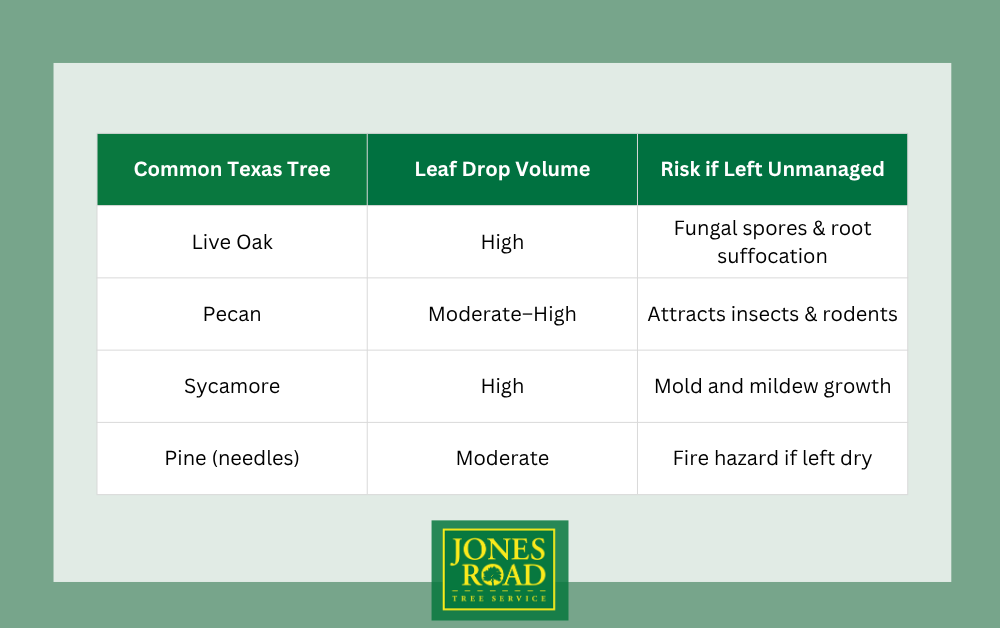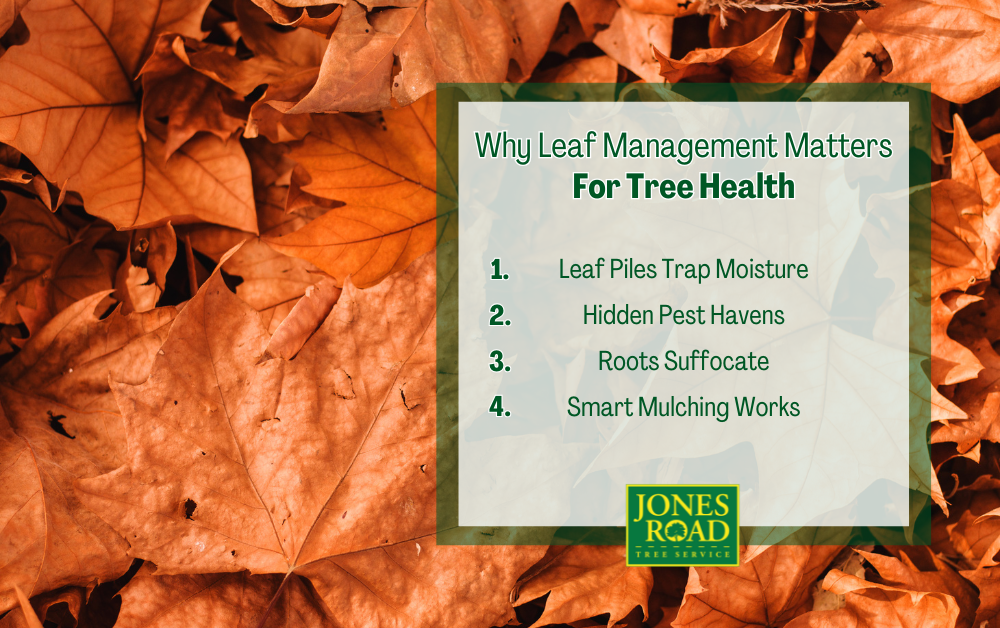When fall rolls around, many homeowners admire the colorful canopy of red, orange, and yellow leaves that scatter across their lawns. But once those leaves hit the ground, they can cause more harm than good if left unmanaged. What looks like a natural blanket is, in fact, a potential breeding ground for pests, fungi, and root issues that directly affect tree health.
Leaf management isn’t just about curb appeal — it’s about protecting the trees that give your property shade, beauty, and value. In this blog, we’ll explore why leaf buildup can harm your trees, practical ways to manage it, and how professional tree care services can help.
In the Houston area, homeowners deal with more than just oak and pecan leaves. The region’s abundant loblolly pines (Pinus taeda) shed dense layers of pine needles that can blanket lawns and tree roots, creating many of the same issues as broadleaf litter when left unmanaged.
The Natural Role of Leaves in the Ecosystem
Before we talk about the problems, it’s important to understand why trees drop their leaves and how this process benefits natural ecosystems.
- Why trees shed leaves: Deciduous trees drop leaves to conserve energy during winter. Without leaves, trees need less water and nutrients.
- Leaf decomposition in forests: In nature, fallen leaves break down slowly, recycling nutrients back into the soil, supporting microbial life, and enriching the root zone.
- Why yards are different: Suburban and urban yards don’t mimic forest ecosystems. Compacted soil, limited root zones, and constant human activity prevent leaves from decomposing naturally. Instead of enriching the soil, unmanaged leaves can cause disease and suffocate roots.
Problems Caused by Excess Leaf Buildup
While a thin layer of leaves can act as a light mulch, too much accumulation leads to major tree health problems.
1. Pest Habitat
Wet, matted leaves create a haven for insects and rodents:
- Termites and ants nesting in piles can migrate to tree trunks.
- Beetles and other boring insects find shelter under leaf mats.
- Rodents, like mice, burrow into leaf piles and chew tree bark.
2. Fungus and Disease
Trapped moisture in leaf piles fosters fungi and bacteria that weaken tree health:
- Root Rot: Waterlogged conditions suffocate roots.
- Powdery Mildew & Leaf Spot: Fungal spores spread back to tree canopies in spring.
- Cankers: Infections weaken bark, inviting more decay.
3. Root Issues
Leaves create a “suffocation blanket” over roots:
- Less oxygen exchange in the soil.
- Reduced water infiltration — puddling above instead of soaking down.
- Increased risk of shallow root systems and instability.
Don’t overlook pine needles. Although they’re smaller than broad leaves, loblolly pine needles can form thick mats that prevent air and water from penetrating the soil. When wet, these layers can also harbor fungal spores and trap moisture around the root flare — both of which threaten overall tree health.
4. Lawn and Plant Damage
Beyond trees, unmanaged leaves harm your yard:
- Grass dies under heavy layers, reducing curb appeal.
- Shrubs and flower beds can become infected by pests and fungi.
Leaf Management Techniques That Support Tree Health
Now that we’ve seen the risks, let’s look at how to manage leaves responsibly.
Proper Raking and Removal
- Rake regularly in November as leaf drop peaks.
- Use lightweight plastic rakes or leaf blowers that won’t compact the soil further.
- Don’t let leaves sit for weeks at a time.
Mulching Leaves the Right Way
Instead of discarding leaves, shred them with a mulching mower:
- Apply a thin 2–4 inch layer around trees.
- Keep mulch away from trunks (“no mulch volcanoes”).
- Benefits include moisture retention, insulation, and nutrient recycling.
Composting Leaves for Soil Enrichment
Turn leaves into garden gold:
- Mix leaves with grass clippings and kitchen waste.
- Over several months, decomposition creates nutrient-rich compost.
- Use finished compost to enhance soil health around tree roots.
Seasonal Considerations in Texas Landscapes
Leaf management isn’t one-size-fits-all. In Texas, especially around Houston and Cypress, certain conditions make November cleanup especially important:
- Heavy leaf producers: Oaks, pecans, and sycamores shed in large volumes.
- Humidity: Moisture lingers in leaf piles, accelerating fungal growth.
- Storm remnants: Hurricane season may be ending, but storm-stressed trees drop extra debris.

How Leaf Management Fits into Overall Tree Health Care
Leaf cleanup is just one piece of the larger tree health puzzle. When combined with other services, it helps trees thrive:
- Soil Aeration & Air Spading → Prevents compaction under leaf piles.
- Deep Root Fertilization → Strengthens roots for winter dormancy.
- Pruning Dead Limbs → Reduces risk of falling branches in storms.
- Pest & Fungus Treatments → Keeps infestations at bay.
When to Call in a Professional
- Proper diagnosis of tree health problems.
- Safe use of treatments (fungicides, pest control).
- Specialized equipment for efficient and safe removal.
Healthy Trees Start with Leaf Management
Whether your property is lined with oaks, pecans, or loblolly pines, leaf and needle management is essential for maintaining long-term tree health. Every species drops organic matter differently — but all benefit from timely cleanup and soil care.
Leaves may look harmless, but neglecting them risks the very tree health you want to protect. From pests and fungi to suffocated roots, unmanaged leaf buildup slowly undermines your landscape. By raking, mulching, composting, or calling in professionals, you can protect your trees while improving soil and yard health.
Don’t wait for leaf buildup to damage your trees. Contact Jones Road Tree Service to schedule a seasonal tree health consultation!




